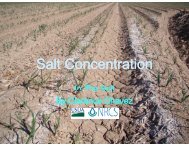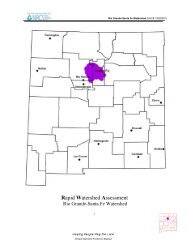SAMPLING VEGETATION ATTRIBUTES - New Mexico NRCS - US ...
SAMPLING VEGETATION ATTRIBUTES - New Mexico NRCS - US ...
SAMPLING VEGETATION ATTRIBUTES - New Mexico NRCS - US ...
You also want an ePaper? Increase the reach of your titles
YUMPU automatically turns print PDFs into web optimized ePapers that Google loves.
METHODS—Point Intercept<br />
• Tripod for mounting sighting device<br />
• Panhead for tripod (makes possible rapid positioning of sighting device)<br />
• Pin or point frame. This can be a pin frame (see Illustration 16), usually with<br />
10 pins (Bonham 1989; Pieper 1973) or a point frame (see Illustration 17),<br />
consisting of two superimposed string grids mounted one above the other on<br />
three adjustable legs (Floyd and Anderson 1983). The design of Floyd and<br />
Anderson (1983) produces a sighting grid of 36 points per frame.<br />
• Hammer<br />
• Permanent yellow or orange spray paint<br />
• Tally counter (optional)<br />
• Two stakes: 3/4 - or 1-inch angle iron not less than 16 inches long<br />
• Compass<br />
• Steel post and driver<br />
• Tape: 50-, 100-, or 200-foot delineated in tenths and hundreds or a metric tape<br />
of the desired length.<br />
5. Training A minimum of training is needed to make sure the examiners understand<br />
how to lay out baselines and transects and position and read the specific<br />
sighting device or pin/point frame being employed. The examiners must also be<br />
able to identify the plant species.<br />
6. Establishing Studies Careful establishment of studies is a critical element in<br />
obtaining meaningful data.<br />
a Site Selection The most important factor in obtaining usable data is selecting<br />
representative areas (critical or key areas) in which to run the study (see Section<br />
II.D). Study sites should be located within a single plant community within a<br />
single ecological site. Transects and sampling points need to be randomly<br />
located within the critical or key areas (see Section III).<br />
b Pilot Studies Collect data on several pilot studies to determine the number of<br />
samples (transects or observation points) and the number and size of quadrats<br />
needed to collect a statistically valid sample (see Section III.B.8).<br />
c Study Layout Data can be collected using either the baseline or linear study<br />
designs described in Section III.A.2 beginning on page 8. The baseline<br />
technique is the recommended procedure.<br />
d Reference Post or Point Permanently mark the location of each study with a<br />
reference post and a study location stake (see beginning of Section III).<br />
e Study Identification Number studies for proper identification to ensure that<br />
the data collected can be positively associated with specific sites on the ground<br />
(see Appendix B).<br />
f Study Documentation Document pertinent information concerning the study<br />
on the Study Location and Documentation Data form (see beginning of Section III<br />
and Appendix A).<br />
7. Taking Photographs The directions for establishing photo plots and for taking<br />
close-up and general view photographs are given in Section V.A.<br />
79




